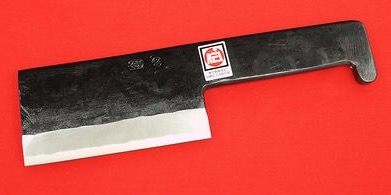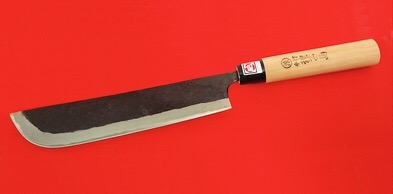I've read about some makers/knives coming from this or that place in Japan (Sakai, Takefu, etc). Does where a maker is located influence anything in style or performance, or is mainly the maker's skills regardless where he comes from? What are the major knife making centers in Japan, and if they differ, how so, and are there any particular stand out makers in those locations?
You are using an out of date browser. It may not display this or other websites correctly.
You should upgrade or use an alternative browser.
You should upgrade or use an alternative browser.
Can someone breakdown the major knife making centers in Japan and how they differ (if they do)?
- Thread starter eazypeazy
- Start date

Help Support Kitchen Knife Forums:
This site may earn a commission from merchant affiliate
links, including eBay, Amazon, and others.
its kind of a long and complicated answer to type... if you want to give me a call at the store one day, i'm happy to explain it all for you
its kind of a long and complicated answer to type... if you want to give me a call at the store one day, i'm happy to explain it all for you
I'd love to hear it in a livestream Q&A if it's something that you feel would be appropriate for that format.
I'd love to hear it in a livestream Q&A if it's something that you feel would be appropriate for that format.
+1 livestream!
no prob... i can do that... just need to find some time soon
Badgertooth
Senior Member
- Joined
- Nov 5, 2015
- Messages
- 2,664
- Reaction score
- 655
And Jon is going to be able to give you amazing detail but here is my observation as an outsider enthusiast.
Seki, more mass produced "factory" style. Lots of VG10, Aus8 & Molybdenum and lower carbon steel. Lots of double bevelled western style knives.
Sakai. A crass simplification but economy of scale is achieved through specialisation. One person forges, another makes handles, another sharpens etc. And from what I gather, the combinations in which these work together is a complex interplay between, contracts, loyalties, capacity,demand & politics. To me the idiom of the knives seem somehow "slinkier" in that they're lower, thinner and pointier (for double bevels at least). Little stylistic idiosyncrasies such as exposed machi also feature. Lots of single bevels and tradition of Honyaki forging still maintained by a few. High carbon hitachi steels are used along with usual suspects in cutlery stainless. Konosuke, Jikko, Ashi Hamono, Hide are the examples that come to mind.
Niigata/sanjo smiths take on more or all of the production steps themselves. Association often by family. Knives feel somehow more substantial. Hitachi steels and cool stuff like Iwasaki Swedish and Heiji semi stainless. Iwasaki legacy felt through smiths Hinoura, Tokifusa Iizuka and Heiji. Brands include Shigefusa, Hinoura, Watanabe, Heiji, Toyama, Yoshikane, Masashi.
Echizen\Takefu loosely co-operative collective of makers under their own names such as Yu Kurosaki, Yoshimi Kato, Takumi Ikeda, Takeshi Saji or as liked under the Masakage brand. Stylistically, the idiom can vary but the high bevelled gyuto with a santokuish profile and not much distal taper is what jumps out though the younger smith's such as Ikeda and sharpener Takayuki have shown an interesting appetite for innovation with new profiles, and use of PM steels. No surprises that more Takefu equivalents of hitachi steels used than in other centres. Takamura and Ryusen are from the area too i think.
Tosa. More rustic edged tools, often Kurouchi finished. Traditional fish knives are often double beveled. And the utility knife profile, funayuki is very useful. I think Blue 1 is favoured. Zakuri springs to mind.
Tanegashima. Super interesting, don't know all that much about it, but the smithing legacy from this southern island being a gunsmithing centre of yore and a scissor making centre. This also plays out with it being a forested area with game. I forget the name of the smith but there is a dento kougeishi down there making beautiful knives and interesting utilitarian knives such as a rock sugar cleaver, and deer bone cleaver and a fish knife called a naginata which is what i would want in a Zombie apocalypse. A Mermaid zombie apocalypse.


Tokyo - not sure but I know Teruyasu Fujiwara makes a hell of a knife. And kiku Kazuhiro looks interesting but I'm not sure how much of stuff like the two Masamotos or Aritsugu is made outside of Tokyo etc.
Again this is pretty loose and I'd love it someone jumped in and corrected obviously wrong stuff and glaring omissions etc.
Seki, more mass produced "factory" style. Lots of VG10, Aus8 & Molybdenum and lower carbon steel. Lots of double bevelled western style knives.
Sakai. A crass simplification but economy of scale is achieved through specialisation. One person forges, another makes handles, another sharpens etc. And from what I gather, the combinations in which these work together is a complex interplay between, contracts, loyalties, capacity,demand & politics. To me the idiom of the knives seem somehow "slinkier" in that they're lower, thinner and pointier (for double bevels at least). Little stylistic idiosyncrasies such as exposed machi also feature. Lots of single bevels and tradition of Honyaki forging still maintained by a few. High carbon hitachi steels are used along with usual suspects in cutlery stainless. Konosuke, Jikko, Ashi Hamono, Hide are the examples that come to mind.
Niigata/sanjo smiths take on more or all of the production steps themselves. Association often by family. Knives feel somehow more substantial. Hitachi steels and cool stuff like Iwasaki Swedish and Heiji semi stainless. Iwasaki legacy felt through smiths Hinoura, Tokifusa Iizuka and Heiji. Brands include Shigefusa, Hinoura, Watanabe, Heiji, Toyama, Yoshikane, Masashi.
Echizen\Takefu loosely co-operative collective of makers under their own names such as Yu Kurosaki, Yoshimi Kato, Takumi Ikeda, Takeshi Saji or as liked under the Masakage brand. Stylistically, the idiom can vary but the high bevelled gyuto with a santokuish profile and not much distal taper is what jumps out though the younger smith's such as Ikeda and sharpener Takayuki have shown an interesting appetite for innovation with new profiles, and use of PM steels. No surprises that more Takefu equivalents of hitachi steels used than in other centres. Takamura and Ryusen are from the area too i think.
Tosa. More rustic edged tools, often Kurouchi finished. Traditional fish knives are often double beveled. And the utility knife profile, funayuki is very useful. I think Blue 1 is favoured. Zakuri springs to mind.
Tanegashima. Super interesting, don't know all that much about it, but the smithing legacy from this southern island being a gunsmithing centre of yore and a scissor making centre. This also plays out with it being a forested area with game. I forget the name of the smith but there is a dento kougeishi down there making beautiful knives and interesting utilitarian knives such as a rock sugar cleaver, and deer bone cleaver and a fish knife called a naginata which is what i would want in a Zombie apocalypse. A Mermaid zombie apocalypse.


Tokyo - not sure but I know Teruyasu Fujiwara makes a hell of a knife. And kiku Kazuhiro looks interesting but I'm not sure how much of stuff like the two Masamotos or Aritsugu is made outside of Tokyo etc.
Again this is pretty loose and I'd love it someone jumped in and corrected obviously wrong stuff and glaring omissions etc.
... which is what i would want in a Zombie apocalypse. A Mermaid zombie apocalypse.
Someone should make a movie about that. And can you imagine the patina on that thing?
+1 for a Livestream by Jon on this!
Thanks Otto, that was a great summary.
- Joined
- Jun 23, 2016
- Messages
- 439
- Reaction score
- 200
KKF should start doing an e-newsletter where Jon does some very informative videos, and Otto does quick text summaries of the videos with his patented succinct but hilarious spin.
Thanks for writing the summary Otto - gives me a decent overview of the knife-related activities of the regions.
chipzaroy
Well-Known Member
- Joined
- Jul 23, 2013
- Messages
- 113
- Reaction score
- 24
And Jon is going to be able to give you amazing detail but here is my observation as an outsider enthusiast.
Seki, more mass produced "factory" style. Lots of VG10, Aus8 & Molybdenum and lower carbon steel. Lots of double bevelled western style knives.
Sakai. A crass simplification but economy of scale is achieved through specialisation. One person forges, another makes handles, another sharpens etc. And from what I gather, the combinations in which these work together is a complex interplay between, contracts, loyalties, capacity,demand & politics. To me the idiom of the knives seem somehow "slinkier" in that they're lower, thinner and pointier (for double bevels at least). Little stylistic idiosyncrasies such as exposed machi also feature. Lots of single bevels and tradition of Honyaki forging still maintained by a few. High carbon hitachi steels are used along with usual suspects in cutlery stainless. Konosuke, Jikko, Ashi Hamono, Hide are the examples that come to mind.
Niigata/sanjo smiths take on more or all of the production steps themselves. Association often by family. Knives feel somehow more substantial. Hitachi steels and cool stuff like Iwasaki Swedish and Heiji semi stainless. Iwasaki legacy felt through smiths Hinoura, Tokifusa Iizuka and Heiji. Brands include Shigefusa, Hinoura, Watanabe, Heiji, Toyama, Yoshikane, Masashi.
Echizen\Takefu loosely co-operative collective of makers under their own names such as Yu Kurosaki, Yoshimi Kato, Takumi Ikeda, Takeshi Saji or as liked under the Masakage brand. Stylistically, the idiom can vary but the high bevelled gyuto with a santokuish profile and not much distal taper is what jumps out though the younger smith's such as Ikeda and sharpener Takayuki have shown an interesting appetite for innovation with new profiles, and use of PM steels. No surprises that more Takefu equivalents of hitachi steels used than in other centres. Takamura and Ryusen are from the area too i think.
Tosa. More rustic edged tools, often Kurouchi finished. Traditional fish knives are often double beveled. And the utility knife profile, funayuki is very useful. I think Blue 1 is favoured. Zakuri springs to mind.
Tanegashima. Super interesting, don't know all that much about it, but the smithing legacy from this southern island being a gunsmithing centre of yore and a scissor making centre. This also plays out with it being a forested area with game. I forget the name of the smith but there is a dento kougeishi down there making beautiful knives and interesting utilitarian knives such as a rock sugar cleaver, and deer bone cleaver and a fish knife called a naginata which is what i would want in a Zombie apocalypse. A Mermaid zombie apocalypse.


Tokyo - not sure but I know Teruyasu Fujiwara makes a hell of a knife. And kiku Kazuhiro looks interesting but I'm not sure how much of stuff like the two Masamotos or Aritsugu is made outside of Tokyo etc.
Again this is pretty loose and I'd love it someone jumped in and corrected obviously wrong stuff and glaring omissions etc.
Thanks for the info! :thumbsup:
Badgertooth
Senior Member
- Joined
- Nov 5, 2015
- Messages
- 2,664
- Reaction score
- 655
Let's take all I've said with a giant pinch of salt. It's 3rd hand at best and my very loosey goosey understanding of it all



